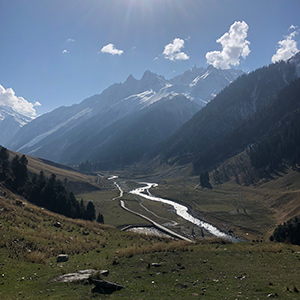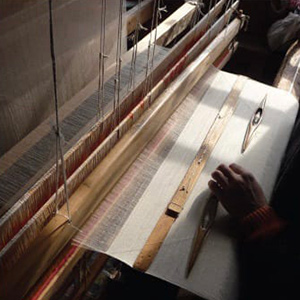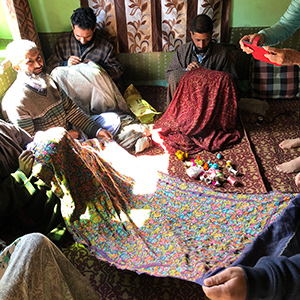Aladdin Treasures of Kashmir - Welcome !

«Kashmir» - the valley of streams & lakes, flowers & fruits where apple and almond orchards are endless...... where the
cherries blossom and is bestowed with their four season. That is why it is called «a paradise on earth».
The history of
Shawl weaving in Kashmir dates back to the period of Hazrat Mir Syed Ali Hamadani (r.a) 1341-1385 A.D. - the famous
sufi saint of Persia, who came to enlighten Kashmir with his spiritual guidance and brought along highly skilled
artisans, who laid base for cottage industries in Kashmir valley. Shawl weaving, carpet weaving, embroideries,
woodcarving , paper-machie and many other handicrafts are still inherited in the families from generation to
generation.
It is said that the shawls were famous from Kashmir even in the times of emperor Ashok (3rd C BC) but many
writers credited Sultan Zain-Ul-Abidin (1420-1470 A.D) as the initiator of Shawl industry in Kashmir.
It may be the
Sultan whose enlightened rule encouraged promotion of arts as an organized trade and the Pashmina or in Persian called
«Pashm» that we know today is a legacy of that period.
The mesmerizing beauty of Kashmir Arts has enchanted emperors, kings and nobleman down the centuries passed on from generation to generation as precious heirlooms. These intricate
and ornate creations continue to be treasured and admired even today. Ardently pursued by lovers of art, the wonders of
Kashmir Arts weave their magic spell all over the world. The ancient magic of Kashmir Arts continues to survive and
thrive in the present age mainly because this rich heritage of craftsmanship and artistic endeavor has been passed on
from generation as timeless tradition.
Aladdin treasures of kashmir is the fourth generation master craftsman dedicated
to reviving and preserving the rich cultural heritage of the fascinating art forms of Kashmir. His endeavor opens the
doorway to a dazzling world of brilliant creativity and breathtaking craftsmanship-designed to hold you spellbound as
you explore an exquisite range of handmade carpets, Pashmina shawls, Kani Jawawars, intricately embroidered dresses...
and more. These creations have created a special niche for Aladdin in the hearts of art lovers both in India and
abroad. Connoisseurs of aesthetics also export its art products to many international destination.
DESCRIPTION OF PASHMINA

Pashmina is a material that is harvested in regions that are located at very high altitude. It is the noblest variety of cashmere, and also the oldest.
In winter, the Changra goat develops much finer and softer hair, especially in the neck and belly areas. This hair is called "pashm" and is a high quality cashmere that the goat will produce only in extreme conditions at high altitude more than 4500 m. This material is harvested in the Himalayas, particularly in Ladakh.
A goat produces about 150g of pashmina per year. The softest and finest hair is harvested in spring, when the goat sheds its winter fleece. This harvest gives an even higher quality.
While a cashmere fiber has a diameter of less than 19 microns, pashmina is finer, less than 15 microns.
THE PASHMINA FROM ANSCIENT TO MODERN CIVILISATIONS
The term pashmina originally comes from Persian language, the word "pashm" means fine quality wool.
For centuries, the Kashmir Valley has been renowned for the weaving of its shawls. The wool comes from the inner winter fleece of Central Asian or Himalayan goats, living at high altitudes. For centuries, cashmere wool has been part of the luxury goods transported by the Silk Road to the Roman Empire. First produced by craftsmen, shawls developed in the 16th century under the regime of Mughal Emperor Akbar, who granted them the status of royal heritage, thus promoting extremely qualitative development.
Harvesting pashmina in Ladakh

To withstand the freezing temperatures of the Himalayan winter reaching -50°C, pashmina goats develop an internal fleece twice as thick as usual. This material is harvested in spring by combing the animal so as to collect the finest and longest hairs, the finest quality being between the region of the neck and the belly of the animal.
This pashmina hair is the main source of income for the nomads who perpetuate the way of life of their ancestors to the rhythm of seasonal transhumance at an altitude of 4600m on the Ladakhi highlands. The price of this material was decided by the Kashmiri government at Rp 3700 for 2 kg. The fibers are then washed and sorted, then the "pashm" hair is transported to the summer capital of Kashmir, Srinagar, which is the only region in the world to master the delicate art of its weaving.
The spinning and weaving of the pashmina
In Srinagar
The Kashmiris have acquired for centuries an unequaled know-how in the weaving of pashmina. The tradition of spinning and weaving is perpetuated from generation to generations.
The spinning of the pashmina

The fleee is first spun by hand using a spinning wheel, a delicate task traditionally carried out by women.
The weaving of the pashmina
The yarn thus obtained will then be woven by hand on traditional wooden looms using very old techniques. One of the most used patterns for making the finest shawls is the bird's eye weave of Bulbul, also known as diamond pattern. This bird is called in Kashmir bird of paradise. The natural color of the wool to be used is natural brown or cream. The fiber will then be colored according to the customer's choice.
Pashmina embroidery

Once the shawls are dyed, then they can be embroidered. The embroidery work is very long, meticulous and extremely precise, exclusively carried out by men to the rhythm of Sufi songs. A shawl can also be woven with colored threads, in patterns of stripes, squares or arabesques directly inserted into the weft.
THE TRUE PASHMINA AND THE FALSE
THE ABSENCE OF THE LABEL
Unlike cashmere wool, the pashmina fiber has never been protected by a label. Purchased by a Chinese industrialist, the PASHMINA brand is widely distributed by means of these characteristic labels which give no indication of composition or material.
The denomination 100% pashmina does not mean that this material is a real pashmina. It can be synthetic such as viscose, polyester or acrylic.
However, rich in tradition and a centuries-old reputation for quality, the term pashmina induces confusion in the minds of consumers that unscrupulous merchants can abuse at their leisure.

